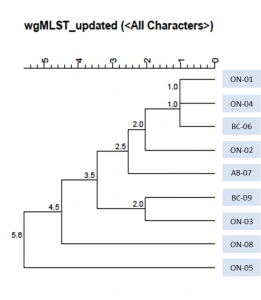Day 14: Thursday, May 21, 2020
While reviewing PulseNet Canada’s weekly WGS summary reports, you notice that there was an update to the previously identified cluster of Salmonella Newport in Ontario (2005NEWWGS-1ON). The cluster now includes a total of nine isolates from British Columbia (n=2), Ontario (n=6), and Alberta (n=1).
Now that the cluster is multi-jurisdictional, the cluster code has changed to the following: 2005NEWWGS-1ON-MP. The “MP” has been added to the end of the cluster code to indicate that this cluster is now multi-jurisdictional.
In order to assess this cluster further, you decide to have a look at the line list for more information and to ask PNC for a quick meeting to review the WGS tree for this cluster.
WGS Tree
You meet with PNC and they share the below WGS tree for the nine cases. There are nine confirmed cases of Salmonella Newport reported in AB (n=1), BC (n=2) and ON (n=6). All nine cases are genetically related by whole genome sequencing (WGS), by 0-6 wgMLST allele differences. This degree of variation indicates that all of these cases were exposed to the same specific strain of Salmonella. These data are consistent with the underlying biological principal that strains that are genetically the same or highly similar are more likely to have originated from a common source and thus provides strong evidence that this is a common source outbreak.
Text description: WGS tree illustrating genetic relatedness of nine cases. Cases are all genetically related by 0-5.6 wgMLST allele differences.
Question 1-4: What factors could be considered when assessing WGS clusters for further follow up?
While assessing this cluster, you use PHAC’s WGS cluster assessment tool. After examining the WGS tree, you decide to look at the laboratory line list from PulseNet Canada to gather further details to inform your assessment of this cluster.
TOOLS
FURTHER READING

